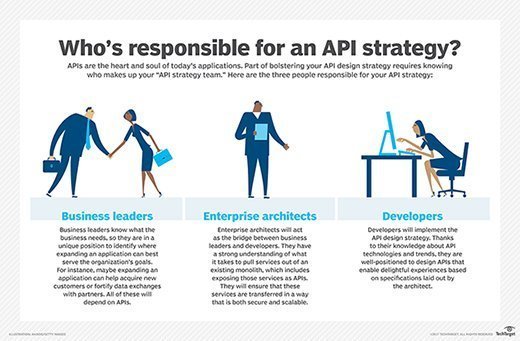
carloscastilla - Fotolia
Manage cloud APIs wisely with these 4 tips
Users can get caught in the weeds of APIs in the cloud. Learn the best tools, top factors and cost optimization techniques for cloud APIs to maximize application performance.
Enterprises built APIs into dozens -- if not hundreds -- of their workloads, making them the foundation of modern application success.
With such great importance, cloud APIs must be managed wisely to ensure success for the business and satisfaction for the end user. IT teams require strong API tools and policies to enable their developers to secure, analyze and monitor their workloads to the best of their abilities.
However, users often struggle to properly manage cloud APIs. Review these four best practices, and begin your journey down the windy road of API management.
Cloud-native vs. third-party tools to manage cloud APIs
Luckily for IT teams, there are multiple tools to pick from to help develop, manage or monitor cloud APIs. But deciding which type of tool -- cloud-native or third-party -- is left up to the developer.
Cloud vendors offer suites of services that tend to focus on cloud APIs' development and performance. AWS, Microsoft and Google offer API Gateway, Azure API Management and Apigee API Management, respectively.
Of course, if teams choose a cloud provider's tool, it also means buying into a vendor's cloud architecture and APIs. This can be an issue for enterprises with a multi-cloud strategy. And, since each vendor offers its own cloud API services, it can significantly complicate integrations across clouds.
On the other hand, third-party tools, like MuleSoft, are focused on the actual management of cloud APIs. Users can combine these services with external orchestration tools -- such as Swagger, LoopBack and Tyk -- to approximate the same capabilities found in cloud vendors' API management offerings. This setup will work across clouds and private data centers, which makes it a clear winner for multi-cloud or hybrid models.

Compare AWS, Microsoft and Google cloud API tools
Amazon API Gateway, Google Cloud Endpoints and Azure API Management provide native support for their respective platforms to help monitor, secure and analyze pain points common with APIs. However, capabilities vary depending on the provider.
Amazon API Gateway stands out for its ability to act as a front end to call on different AWS Lambda functions. This enables users to spin up functions as needed, though it requires additional effort to set up connections to private clouds. AWS provides tools to help customers handle specific needs within Amazon API Gateway, such as configuration, authentication, scaling, code management or mock service integration.
Unlike AWS, Microsoft provides its own developer and admin interface to aid API testing instead of the mock service integration. Azure API Management users can incorporate Active Directory and Azure Monitor to manage developer access and track API performance, respectively.
Google Cloud Endpoints supports coding for applications within Google Cloud but has yet to tackle how it will service governance or Google Cloud Functions. With that said, Google does offer Apigee API Management for its customers that implement multi-cloud or hybrid strategies. Google users can customize management within OpenAPI and use the developer portal to access different tools. Cloud Platform Console can be used to monitor and analyze APIs, while Google API keys help manage access to Google Cloud Endpoints.
Top factors for cloud API success
As the popularity of microservices rises, API complications rise with it. These problems are primarily caused by APIs that are preforming duplicate tasks, which can lead to repeated development efforts and conflicting changes.
API management typically comes down to three key factors: discovery and documentation; monitoring and alerting; and security and authentication.
APIs often share the same authentication method -- whether that's OAuth, JSON or API key authentication. This layer of protection -- or API gateway -- can then notify a specific API of a user's authentication request. But users must understand that an API gateway may not be enough. Additional firewalls can be put in place, as well as access control policies and validation practices.
APIs depend on different outside connections. If any of the connections fail, a ripple effect can occur. Operations teams should use API management systems to log services and conduct status checks to notify users of potential failures as quickly as possible.
Developers can also register their APIs in one place to enable their team to have a more hands-on monitoring practice. Or they can use Postman, a tool that enables developers to create mock endpoints and continually monitor their APIs on one platform.
Finally, they can use API discovery and documentation tools to share common code and understand if a particular issue has been faced in the past by someone else in the company.
Cloud billing APIs lead to cost transparency
Organizations want transparency from their cloud platforms. And, while cloud vendors have lifted the curtain to give users a greater understanding of cloud service pricing, it's still difficult to track those costs.
AWS, Microsoft and Google have all improved their cloud billing APIs to give customers greater access to cost information. For example, the Google Cloud Billing Catalog API provides real-time access to pricing, while the AWS Cost Explorer API and the Azure Billing APIs provide data on their respective platforms. These tools, along with other improvements in vendors' cost management services, should enable simpler, more granular analysis of spending behavior.
With this added visibility into workloads, users are better informed regarding decisions to discard unneeded or underused resources that can contribute to high costs. If a company uses a multi-cloud model, third-party cost management tools will give it a better understanding of costs across environments.








